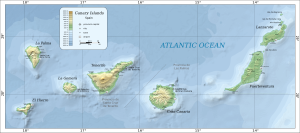 Our text introduces us to these off islands which are part of the chain of Canary Islands. The main islands of Tenerife and Grand Canary are popular tourist destinations for Europeans, although not for Americans given their distance from our shores. But the far flung Chinijo Archipelago attract less interest and indeed are now preserved parklands.
Our text introduces us to these off islands which are part of the chain of Canary Islands. The main islands of Tenerife and Grand Canary are popular tourist destinations for Europeans, although not for Americans given their distance from our shores. But the far flung Chinijo Archipelago attract less interest and indeed are now preserved parklands.
Still, we can see the interest in visiting these quiet nature spots growing.
This leads me to think about tourism. As a tourist I love visiting new places, exploring, shopping, taking tons of pictures, and enjoying local food and life. But as a resident of the East End of Long Island, I see tourism quite differently. I grew up in Amagansett, a small town between the rich East Hampton and the fisherfolk Montauk. It was a real town, with useful stores, quiet streets, a bit more life in the summer months, but generally our town had an air of being, well–our town. Now it has morphed into a summer frat party with noise, expensive and useless boutiques, and crowds by the hundreds. Residents feel the onslaught of the party crowd. My family house was bulldozed to make room for a McMansion, squeezed onto its tiny place on Miankoma Lane. We feel besieged by these tourist crowds.
Alas, the same might be said for the North Fork as both summer crowds and fall traffic builds up, bumper to bumper, for the dreaded “Pumpkin picking season.” Now, I am not against fun and I understand people wanted to enjoy the beauty of the South and North Forks, but when has tourism gone too far?
I can understand the dilemma faced by nature and by the people who have lived in communities when outsiders overwhelm locals and begin to change the character of a community from being a community to being a tourist destination. True, tourism brings money and many of my neighbors survive on summer trade as I am sure residents of the Chinijo islands do.
Where can we find balance? When does tourism help and when does it hurt? What does it mean to be a “good tourist” or is that not possible? How can those who live in a community welcome outsiders but retain their sense of community and preserve their place?



One Response to Chinijo Archipelago: a tourism dilemma